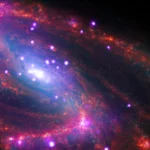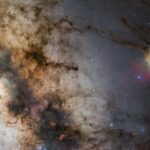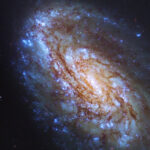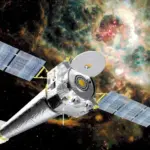A recent Chandra study of the cluster on the right side of the image, named NGC 2237, provides the first probe of the low-mass stars in this satellite cluster. Previously only 36 young stars had been discovered in NGC 2237, but the Chandra work has increased this sample to about 160 stars. The presence of several X-ray emitting stars around the pillars and the detection of an outflow — commonly associated with very young stars — originating from a dark area of the optical image indicates that star formation is continuing in NGC 2237 (the outflow and some of the pillars are labelled in a close-up view). By combining these results with earlier studies, the scientists conclude that the central cluster formed first, followed by expansion of the nebula, which triggered the formation of the neighbouring clusters, including NGC 2237.
This work was led by Junfeng Wang of the Harvard-Smithsonian Center for Astrophysics. The co-authors were Eric Feigelson, Leisa Townsley, Pat Broos and Gordon Garmire from Penn State University, Carlos Roman-Zuniga from the German-Spanish Astronomical Center in Spain, and Elizabeth Lada from the University of Florida.












![Space Streams - Nebula [Ambient] image](https://space-streams.com/wp-content/uploads/2024/11/space-streams-nebula-150x150.png)






































